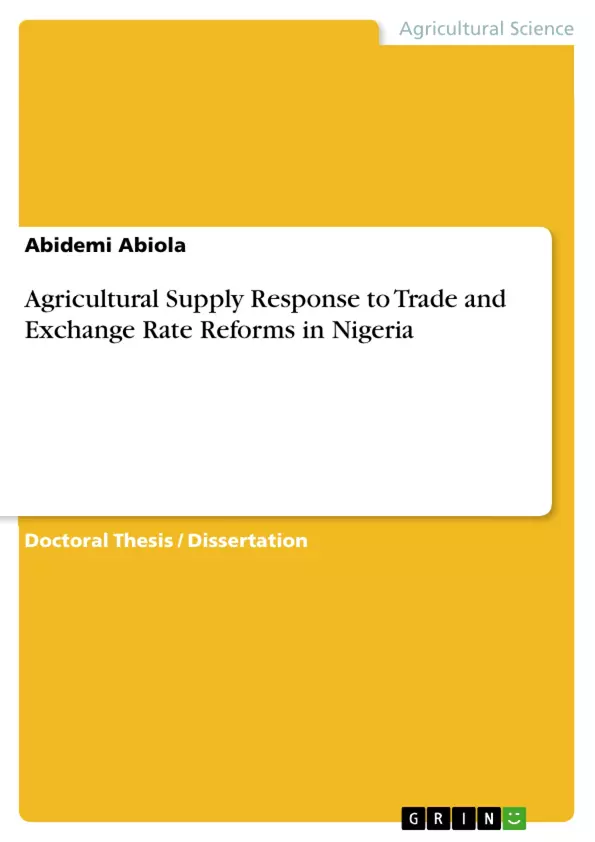The study was anchored on theories of production and supply response. A Nerlovian supply response model (1956) as modified by Karbasi and Tavana (2008) which captures the impact of trade and exchange rate reforms on agricultural commodities prices and outputs, and with acreage cultivated, labour and cost of agricultural machinery as control variables was explored. Major cash crops (cocoa, palm produce, palm kernel, groundnuts, rubber and cotton) and food (cassava, maize, yam and rice accounting for 28.0% of the 40.0% of staple food output) were purposively selected. Data were collected from the World Trade Organisation Trade Statistics, World Bank UN-COMTRADE statistics and World Development Indicators; Food and Agricultural Organisation Year Book Statistics and Agricultural Market Access Database; Central bank of Nigeria’s Statistical Bulletin and National Bureau of Statistics Annual Abstracts of Statistics. A Structural Vector Autoregression model was estimated via the generalized Impulse response functions and variance decomposition estimation techniques. All estimates were validated at p≤0.05.
Trade policy shifted from a restrictive regime in 1970 to a liberalized regime starting from1995. Exchange rate policy similarly moved from a fixed regime in 1970 to a managed/float regime from 1986 to 2013. These reforms had diverse significant effects on both the prices and outputs of all sampled agricultural commodities. Trade effect was positive for palm kernel, cotton, rubber and cassava, while negative for the others. The effects were permanent across the ten commodities, while the elasticities for all the commodities range between 0.002 and 0.05. Exchange rate effect was positive for palm kernel, cotton, maize and rice, while negative for the others. The effects were also permanent except for rubber which was transitory, while elasticities for the commodities range between 0.1 and 2.3. On aggregate, the cost of machinery was found to be negatively related to the commodities outputs. A percentage increase in the cost of machinery brings about a 15.0 percent decline in output. Land and labour were positively and negatively related to output, respectively. An additional acre of land cultivation increased aggregate supply by 31.1%, while an increase in the use of labour decreased output by 19.0%.
Trade and exchange rate reforms were critical in explaining the supply responses of sampled commodities, hence, the need for favourable and stable reforms.
Inhaltsverzeichnis (Table of Contents)
- ABSTRACT
- DEDICATION
- ACKNOWLEDGEMENTS
- CHAPTER ONE: INTRODUCTION
- 1.1 Background to the Study
- 1.2 Statement of the Problem
- 1.3 Objectives of the Study
- 1.4 Research Questions
- 1.5 Significance of the Study
- 1.6 Scope of the Study
- 1.7 Limitations of the Study
- 1.8 Organization of the Study
- CHAPTER TWO: LITERATURE REVIEW
- 2.1 Theoretical Framework
- 2.2 Conceptual Framework
- 2.3 Empirical Review
- 2.4 Gaps in Literature
- CHAPTER THREE: METHODOLOGY
- 3.1 Study Area
- 3.2 Data Source
- 3.3 Model Specification
- 3.4 Data Analysis
- 3.5 Expected Results
- CHAPTER FOUR: DATA PRESENTATION AND ANALYSIS
- 4.1 Descriptive Statistics
- 4.2 Model Estimation
- 4.3 Impulse Response Analysis
- 4.4 Variance Decomposition
- 4.5 Discussion of Findings
- CHAPTER FIVE: SUMMARY, CONCLUSION AND RECOMMENDATION
- 5.1 Summary of Findings
- 5.2 Conclusion
- 5.3 Recommendations
- REFERENCES
Zielsetzung und Themenschwerpunkte (Objectives and Key Themes)
This doctoral thesis investigates the impact of trade and exchange rate reforms on agricultural supply response in Nigeria from 1970 to 2013. The study aims to assess how these reforms affected the prices and outputs of major cash and food crops, thereby contributing to a better understanding of the interplay between macroeconomic policies and agricultural productivity.
- Impact of Trade and Exchange Rate Reforms on Agricultural Supply Response in Nigeria
- Analysis of Price and Output Dynamics of Major Cash and Food Crops
- Exploration of the Effects of Macroeconomic Policies on Agricultural Productivity
- Contribution to the Body of Knowledge on Agricultural Supply Response in Developing Countries
- Identification of Policy Implications for Enhancing Agricultural Growth and Development in Nigeria
Zusammenfassung der Kapitel (Chapter Summaries)
- Chapter One: Introduction provides background information on agricultural supply response (ASR) in Nigeria, outlining the context and significance of trade and exchange rate reforms. It states the research problem, objectives, and research questions, emphasizing the need to investigate the effects of these reforms on agricultural production.
- Chapter Two: Literature Review examines theoretical and empirical studies related to ASR and the impact of trade and exchange rate reforms on agricultural output. It provides a comprehensive overview of existing literature and identifies gaps in knowledge that the current study aims to address.
- Chapter Three: Methodology details the research methodology employed in the study, including the study area, data sources, model specification, data analysis techniques, and expected results. This chapter outlines the methods used to gather and analyze data to answer the research questions.
- Chapter Four: Data Presentation and Analysis presents the findings of the study, including descriptive statistics, model estimations, impulse response analysis, and variance decomposition. This chapter analyzes the impact of trade and exchange rate reforms on agricultural output, focusing on the dynamics of prices and production for various commodities.
Schlüsselwörter (Keywords)
This thesis focuses on the impact of trade and exchange rate reforms on agricultural supply response in Nigeria. It delves into the dynamics of prices and outputs of major cash and food crops, highlighting the effects of macroeconomic policies on agricultural productivity in a developing country context. The study utilizes various econometric models and data analysis techniques to assess the relationship between policy reforms and agricultural output.
- Citation du texte
- Abidemi Abiola (Auteur), 2017, Agricultural Supply Response to Trade and Exchange Rate Reforms in Nigeria, Munich, GRIN Verlag, https://www.grin.com/document/447234



